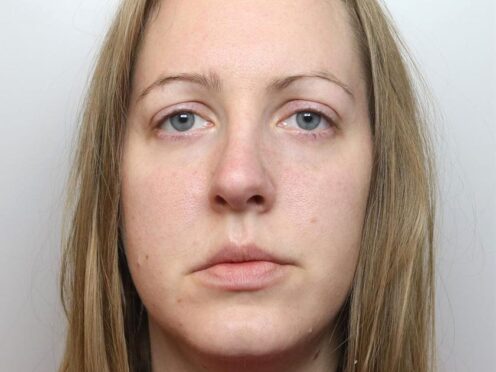‘Certain’ babies are capable of dislodging their own breathing tubes, a nurse has told the attempted murder trial of Lucy Letby.
Killer nurse Letby, 34, is on trial at Manchester Crown Court accused of displacing the tube of a baby girl which is said to have led to a sudden deterioration in her condition during a night shift at the Countess of Chester Hospital’s neo-natal unit.
It is alleged she struck when the infant’s designated nurse left the unit to update her parents on the labour ward about the wellbeing of their child and a pending transfer to a specialist hospital because of her extreme prematurity.
Child K was born less than two hours earlier at 2.12am on February 17 2016 at 25 weeks’ gestation, weighing 1lb 8oz (692g).

Consultant paediatrician Dr Ravi Jayaram is said to have caught her “virtually red-handed” as he entered the unit’s intensive care room and said he saw Child K’s blood oxygen levels dipping on the monitor screens but no alarms were going off as they should have done.
He has told jurors that he saw “no evidence” of Letby having done anything to help Child K and that he heard no call for help as he sat nearby at a desk at the central nurses’ station.
On Thursday, Band 6 nurse Joanne Williams told the court that she could not remember if she asked a specific colleague to watch Child K while she was absent but three other registered nurses, including Letby, were on the night shift and the practice was to work as “a team”.
Her nursing notes recorded her leaving the unit at 3.30am but she said she could not recall the precise time.
Prosecutor Nick Johnson KC asked: “What condition was (Child K) in when you left at whatever time it was?”
Ms Williams said: “She would have been stable to the point at what was acceptable for a 25-weeker baby … otherwise I would not have left.”
Mr Johnson said: “Would you have been gone long?”
Ms Williams said: “No, because I would have been very conscious to come back to (Child K) and support the rest of the nursing staff and the other babies on the unit.”
Door swipe data logged her re-entering the unit at 3.47am when she said she could hear alarms going off from nursery one, the intensive care room.
Mr Johnson said: “Can you remember anything you saw when you got to nursery one?”
Ms Williams said: “Just that people were in the room and the alarms were going off. I remember Dr Jayaram being in the room and Lucy being in the room.”
Mr Johnson said: “Do you remember what was being done by Dr Jayaram or Lucy Letby?”
Ms Williams said: “No, not at that time.”
Mr Johnson pointed out that her nursing notes from the night had queried whether the ET (endrotracheal) tube had dislodged.
He asked: “Was that the working theory at the time?”
Ms Williams said: “If I had written that, then yes.”
Ben Myers KC, defending, asked the witness: “In your experience, is it possible that tubes slip or move?”
“Yes,” said Ms Williams.

Mr Myers said: “And babies are capable of dislodging tubes, do you agree?”
Ms Williams replied: “Certain babies, yes.”
Mr Myers said: “If they are active they can dislodge them?”
“Yes,” said Ms Williams.
Mr Myers said: “Your initial recollection was that Child K was active, and and an active baby can dislodge a tube?”
“Yes,” she repeated.
Ms Williams added she had “not very much” experience at that time in dealing with babies of 25 weeks’ gestation.
Mr Myers drew attention to a witness statement previously made by Ms Williams in which she said she re-entered nursery one and recalled Dr Jayaram asking ‘What’s happened? How as this happened?’ and she replied ‘I don’t know, I was with the parents’.
Mr Myers went on: “He was asking you who was in the room at the time the alarms went off, wasn’t he?”
Ms Williams said: “He did, yes.”
Child K was transferred to Wirral’s Arrowe Park Hospital later on February 17 and died there three days later although the prosecution does not allege Letby caused her death.
Letby, of Hereford, denies a single count of attempted murder.
The jury of six men and six women has been told that Letby was convicted at a trial last year of the murders of seven babies – five before February 2016 – and the attempted murders of six other infants at the Countess of Chester between June 2015 and June 2016.
A court order prohibits reporting of the identities of the surviving and dead children involved in the case.
Jurors were told that alarms on the monitors in the intensive care room could be paused for one-minute intervals, or silenced, which generally happened when medical staff were dealing with an ongoing issue.
The trial was adjourned until Friday.
